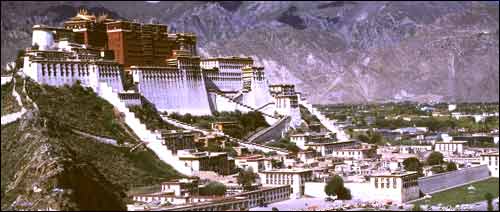Tibet Tourism
Created | Updated Feb 21, 2009

Tourists may play an unwitting role in the Chinese destruction of Tibetan culture - or, with a little care, help the Tibetan people by spending wisely, observing closely, and bearing witness to what they see.
Background Information
For most of its long history, Tibet remained a forbidding place, closed to foreign adventurers and diplomats alike. After the invasion of Tibet by China in 1950, and particularly during the brutal excesses of the Chinese Cultural Revolution (1966 - 1976), the veil thrown over the Tibetan plateau was there to conceal the guilty secrets of a cruel and destructive occupation.
As the political pendulum swung again in Beijing, a new era of detente with Western governments led to a slight loosening of borders and some travel in and out of Tibet. Many Tibetans took advantage of this opportunity to escape into exile, many returned to Tibet after leaving their children behind in India and Nepal, where they would be cared for and educated by the growing exile communities.
In 1987, a small group of western tourists in Lhasa witnessed first-hand the crushing repression of China's occupation of Tibet, when police fired into a crowd of unarmed demonstrators1. When, in 1989, paramilitary police again crushed a pro-independence protest, killing more than 100 people, western tourists were on hand with their video cameras. For many people the appearance on the evening news of monks being kicked and clubbed was their first inkling of the plight that Tibetans had to that point already endured for 40 years.
It is easy to see, then, that the issue of tourism in Tibet is one fraught with serious political and human rights implications: for China, Tibet is seen as a source of revenue and as a means of showcasing China's 'development' of a 'backward' land. China's state-sponsored tourism industry encourages foreigners to spend while experiencing carefully controlled aspects of 'China's Tibet'. This control has recently been tightened by dismissing many Tibetan tour guides and replacing them with politically-reliable Chinese guides. Contact with Tibetans, under the scrutiny of ever-vigilant security personnel, is often furtive and, for Tibetans, dangerous.
Some travellers are reluctant to support China's occupation of Tibet by spending their holiday money there. The Dalai Lama, however, prefers that people choose to visit Tibet in order to see for themselves the conditions under which Tibetans live. Nevertheless, visitors should remember that China has invested a great deal in promoting some views of Tibet and carefully hiding others.
Travel Advice
Visas for Tibet are complicated and you need to be careful. Tibet Information Network (TIN) provides very comprehensive advice on its website with Travel to Tibet. This is an excellent place to begin if you are considering a trip to Tibet.
The Chinese government wants tourists to move around in large groups, and you will find it difficult to break away from those groups. If you go from Nepal, your travel agent may promise you various things, but you're still likely to find yourself mainly on a bus.
The following is a brief overview of some considerations prospective visitors to Tibet should bear in mind:
General:
- Be prepared to suffer some degree of altitude sickness, which can range from mild headache and nausea to life-threatening illness; consult your doctor before you go.
- Wherever possible, support Tibetan tour operators and tour guides.
- Support Tibetans by buying only from Tibetan vendors.
- Eat Tibetan food, prepared and served by Tibetans; avoid Chinese and other imported food.
- Do not buy antiques! Tibetans have already been robbed of most of their antiquities. Anybody who whispers, 'Pssst... you wanna buy a ____?' probably has no right to sell it2.
- Do not buy souvenirs made from Tibet's endangered wildlife; much of Tibet's native fauna, once abundant, now faces extinction.
- Canada Tibet Committee suggests, 'If you want to bring presents for locals along the way, think carefully. Don't bring plastic baubles or contribute to begging by handing out a lot of freebies. It's much more appropriate to share time and a cup of tea with people, or play a game of jacks with the children.
- An useful option for giving presents is to bring something like pencils or balloons and give them to a local schoolteacher for controlled distribution.
Religious Sites:
- Show proper respect for Tibetan customs by always walking in a clockwise direction around religious sites. When visiting monasteries, shrines, or temples, dress conservatively, remove your hat, and do not smoke.
- Similarly, prayer wheels should always be spun in a clockwise direction.
- Do not touch religious art in temples and monasteries. Do not use flash photography unless you are invited to do so.
- Show all due respect by not intruding on religious practices which may be taking place when you visit.
- Do not touch monks or nuns; this is considered disrespectful.
- Stay away from Tibetan funeral rites, even if your tour guide invites you to attend; such things are private and are not meant for the merely curious.
- Give donations directly to monks and nuns - or place them, where appropriate, on the altar; money placed in official collection boxes may benefit the Communist Party more than the religious site you are visiting.
- Canada Tibet Committee suggests, 'A wonderful way to spend some time with monastic people is to share your food. Walk the Barkhor at sunrise with the Tibetans! It's a peaceful experience and allows you to be with the Tibetan people in a way that shows you support their religious freedom.'

